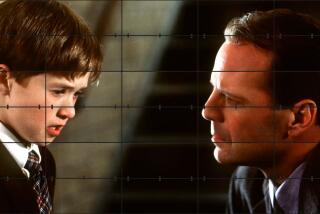Cultural Exchange: The action hero comes to Bollywood
- Share via
Reporting from Mumbai, India — — Early in the Bollywood film “Bodyguard,” leading man Salman Khan performs what is arguably the world’s first muscle dance. That is, wearing a sleeveless denim jacket, he glares into the camera and flexes his biceps to the beat of the song. In case you miss the point of the pulsating brawn, the lyrics of the song noisily declare that the Bodyguard is the hottest and toughest man in town. After which, the story of his extremely convoluted love affair with the lady he is guarding proceeds.
“Bodyguard,” essentially a superhero minus the cape tale, is the second-largest-grossing film in the history of Hindi cinema. Its approximately $4-million opening day shattered records. The film went on to gross about $46 million worldwide and is the No. 1 movie of the year in India. The No. 3 film, “Singham” or Lion, features a protagonist who could be the Bodyguard’s brother from another mother. Bajirao Singham, a small-town cop, is also upright, honest and everybody’s pride and joy. He too routinely beats to a pulp any baddie who crosses his path.
Coming Wednesday is Bollywood’s most expensive and hyped film of the year — “Ra.One,” a sci-fi fantasy in which Shah Rukh Khan, Hindi cinema’s favorite romantic hero, has donned a latex suit. He’s playing a blue-eyed video game character who pops out of the game and into the real world to do battle with an evil power and save the world. “Ra.One,” a 3-D extravaganza, that the actor has also co-produced, will go out on 3,500 screens worldwide, including the U.S., with extensive merchandising, its own video game and a graphic novel.
These films mark the ascent of a new kind of hyper-masculine superhero in Bollywood. Hindi films have largely steered clear of literal superheroes — men with costumes and special powers are rare (the box office response to “Ra.One” might change this). But the Hindi film hero has traditionally been larger than life. He is unblemished, upstanding, a Man with a capital M who can woo the girl, save the world and also, when required, break into a song. Or at least that used to be the case.
Over the last 15 years, this kind of earthy superhero was sidelined by a slicker model — the yuppie exemplified by superstar Shah Rukh Khan. In a series of blockbusters, he played an urbane, romantic hero who relied more on brain than brawn and spoke an international language of cool. His most enduring film, “The Bravehearted Will Take the Bride” (1995), features him as Raj, a London-based, Lamborghini-driving boy who follows the girl he loves to India, lies to her disapproving family and wins them over, one by one.
This determinedly upmarket, metrosexual man was the perfect fit for the new post-economic reform India, in which the urban middle-class, consumerism and multiplex culture were gaining ground. Simultaneously, Bollywood’s overseas market boomed (the 25 million Indians scattered around the globe are big fans) and these lightweight tales of beautiful people in designer clothes struggling with matters of the heart moved base. Bollywood films were now as likely to be set in New York as in New Delhi.
Not surprisingly, large swathes of viewers, especially in smaller towns and villages, found these narratives so foreign that they switched to regional cinema where the old rules still held. “The problems of the nonresident Indian didn’t translate to the masses,” said actor Ajay Devgn, who plays Singham. “They look at a guy sitting in a leather jacket in New York and wonder what problems could this guy have.”
But little is lost in translation when Devgn pounds a corrupt politician into the ground in “Singham.” Or Salman Khan, an early champion of chiseled muscles and six-pack abs, pulverizes his opponents with his bare hands in a slew of action movies with names like “Wanted” and “Dabangg” (Fearless). The slickly choreographed fight sequences in these movies were a big draw — the violence was hard-hitting but rarely gory enough to turn away women or younger viewers. These raw, uncomplicated men made the sensitive, effete hero passé and worked for all demographics.
“In parts of the country where stories like ‘Dabangg’ are set, life hasn’t changed much from how it was in pre-liberalization days,” writer Jaideep Sahni said. “The unfairness, hopelessness and feeling of futility remains as it always was, and a film like ‘Dabangg’ works there as it always did. So the magical advantage of the hero spectacle is that in smaller centers they are seen to represent something real and heartfelt and in the bigger centers they are seen as ‘masala-cool,’ so it works every time, which is of course the Holy Grail of the producer.”
These masala movies (essentially old-school style spicy blends of action, romance, comedy, thundering dialogue and drama) have brought an Indian flavor back on screen. Filmmakers who were in hot pursuit of exotic foreign locations are now scouring the country for authentic backdrops.
As Rachel Dwyer, professor of Indian cinema at the University of London, put it: “Films in ‘real India’ are gaining ground. Perhaps the metrosexual hero was just that — popular in the metros. It suggests the diminishing importance of the overseas market and the rise of the power of the domestic one.” Devgn believes that these viewers are necessarily seeking a larger than life film. “That’s what a theater experience is meant to be,” he said.
More to Read
The biggest entertainment stories
Get our big stories about Hollywood, film, television, music, arts, culture and more right in your inbox as soon as they publish.
You may occasionally receive promotional content from the Los Angeles Times.










